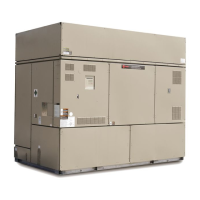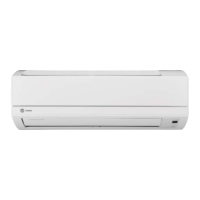RT-SVX24J-EN 45
Installation
Roof Curb and Ductwork
The roof curbs for units consist of two main components;
a pedestal to support the unit condenser section and a“full
perimeter” enclosure to support the unit air handler
section.
Before installing any roof curb, verify;
1. That it is the correct curb for the unit,
2. That it includes the necessary gask ets and hardware
3. That the purposed installation location provides the
required
clearance for proper operation.
4.
ensure that the curb is level and square.The top
surface of the curb must
be true to assure an adequate
curb-to-unit seal.
Step-by-step curb assembly and installation instructions
ship with eachTrane accessory roof curb kit. Follow the
instructions carefully to assure proper fit-up when the unit
is set into place.
Note: To assure proper condensate flow during
operation, the unit (and curb) must be as level as
possible.The maximum slope allowable for
rooftop unit applications, excluding Steam Heat
Units, is 4" end-to-end and 2" side-to-side. Units
with steam coils must be set level!
If the unit is elevated, a field constructed catwalk around
the unit is strongly recommended to provide easy access
for unit maintenance and service. Recommendations for
installing the Supply Air and Return Air ductwork joining
the roof curb are included in the curb instruction booklet.
Curb ductwork must be fabricated and installed by the
installing contractor before the unit is set into place.
Note: For sound consideration, cut only the holes in the
roof deck for the ductwork penetrations. Do not cut
out the entire roof deck within the curb perimeter.
Pitch Pocket Location
The location of the main supply power entry is located at
the bottom right-hand corner of the control panel.
Figure 16, p. 46 illustrates the location for the electrical
entrance through the base in order to enter the control
panel. If the power supply conduit penetrates the building
roof beneath this opening, it is recommended that a pitch
pocket be installed before the unit is placed onto the roof
curb.
The center line dimensions shown in the illustration below
indicates the center line of the electrical access hole in the
unit base when it is positioned on the curb, ±3/8 inch.The
actual diameter of the hole in the roof should be at least 1/
2 inch larger than the diameter of the conduit penetrating
the roof.This will allow for the clearance variable between
the roof curb rail and the unit base rail illustrated in
Figure 17, p. 46.
The pitch pocket dimensions listed are recommended to
enhance the application of roofing pitch after the unit is set
into place.The pitch pocket may need to be shifted as
illustrated to prevent interference with the curb pedestal.
If aTrane Curb Accessory Kit is not used:
a. The ductwork can be attached directly to the unit
bottom, around the unit supply and return air
openings. Be sure to use flexible duct connections
at the unit.
b. For “built-up” curbs supplied by others, gaskets
must be installed around the curb and the supply
and return air opening perimeters.
Notes:
• If a“built-up” curb is provided by others, it should NOT
be made of wood.
• If a “built-up” curb is provided by others, keep in mind
that these commercial rooftop units do not have base
pans in the condenser section.
• If this is a REPLACEMENT UNIT keep in mind that the
CURRENT DESIGN commercial rooftop units do not
have base pans in the condenser section.
Figure 15. Solid flow baffle wall installation for non-
Trane roof curbs
Return Fan
Roof Curb
Return Airflow
Flow Baffle
Return Airflow
Duct

